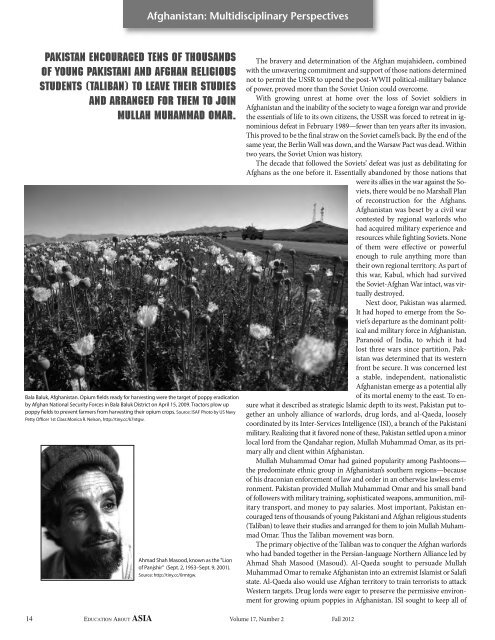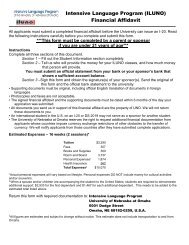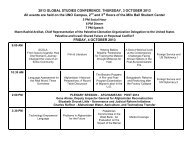What History Can Teach Us about Contemporary Afghanistan
What History Can Teach Us about Contemporary Afghanistan
What History Can Teach Us about Contemporary Afghanistan
Create successful ePaper yourself
Turn your PDF publications into a flip-book with our unique Google optimized e-Paper software.
Pakistan encouraged tens of thousands<br />
of young Pakistani and Afghan religious<br />
students (Taliban) to leave their studies<br />
and arranged for them to join<br />
Mullah Muhammad Omar.<br />
Bala Baluk, <strong>Afghanistan</strong>. opium fields ready for harvesting were the target of poppy eradication<br />
by Afghan National Security Forces in Bala Baluk District on April 15, 2009. Tractors plow up<br />
poppy fields to prevent farmers from harvesting their opium crops. Source: iSAF Photo by US Navy<br />
Petty officer 1st Class Monica R. Nelson, http://tiny.cc/k7ntgw.<br />
<strong>Afghanistan</strong>: Multidisciplinary Perspectives<br />
Ahmad Shah Masood, known as the "Lion<br />
of Panjshir" (Sept. 2, 1953–Sept. 9, 2001).<br />
Source: http://tiny.cc/0rmtgw.<br />
14 EDUCATION ABOUT ASIA Volume 17, Number 2 Fall 2012<br />
The bravery and determination of the Afghan mujahideen, combined<br />
with the unwavering commitment and support of those nations determined<br />
not to permit the USSR to upend the post-WWII political-military balance<br />
of power, proved more than the Soviet Union could overcome.<br />
With growing unrest at home over the loss of Soviet soldiers in<br />
<strong>Afghanistan</strong> and the inability of the society to wage a foreign war and provide<br />
the essentials of life to its own citizens, the USSR was forced to retreat in ignominious<br />
defeat in February 1989—fewer than ten years after its invasion.<br />
This proved to be the final straw on the Soviet camel’s back. By the end of the<br />
same year, the Berlin Wall was down, and the Warsaw Pact was dead. Within<br />
two years, the Soviet Union was history.<br />
The decade that followed the Soviets’ defeat was just as debilitating for<br />
Afghans as the one before it. Essentially abandoned by those nations that<br />
were its allies in the war against the Soviets,<br />
there would be no Marshall Plan<br />
of reconstruction for the Afghans.<br />
<strong>Afghanistan</strong> was beset by a civil war<br />
contested by regional warlords who<br />
had acquired military experience and<br />
resources while fighting Soviets. None<br />
of them were effective or powerful<br />
enough to rule anything more than<br />
their own regional territory. As part of<br />
this war, Kabul, which had survived<br />
the Soviet-Afghan War intact, was virtually<br />
destroyed.<br />
Next door, Pakistan was alarmed.<br />
It had hoped to emerge from the Soviet’s<br />
departure as the dominant political<br />
and military force in <strong>Afghanistan</strong>.<br />
Paranoid of India, to which it had<br />
lost three wars since partition, Pakistan<br />
was determined that its western<br />
front be secure. It was concerned lest<br />
a stable, independent, nationalistic<br />
<strong>Afghanistan</strong> emerge as a potential ally<br />
of its mortal enemy to the east. To ensure<br />
what it described as strategic Islamic depth to its west, Pakistan put together<br />
an unholy alliance of warlords, drug lords, and al-Qaeda, loosely<br />
coordinated by its Inter-Services Intelligence (ISI), a branch of the Pakistani<br />
military. Realizing that it favored none of these, Pakistan settled upon a minor<br />
local lord from the Qandahar region, Mullah Muhammad Omar, as its primary<br />
ally and client within <strong>Afghanistan</strong>.<br />
Mullah Muhammad Omar had gained popularity among Pashtoons—<br />
the predominate ethnic group in <strong>Afghanistan</strong>’s southern regions—because<br />
of his draconian enforcement of law and order in an otherwise lawless environment.<br />
Pakistan provided Mullah Muhammad Omar and his small band<br />
of followers with military training, sophisticated weapons, ammunition, military<br />
transport, and money to pay salaries. Most important, Pakistan encouraged<br />
tens of thousands of young Pakistani and Afghan religious students<br />
(Taliban) to leave their studies and arranged for them to join Mullah Muhammad<br />
Omar. Thus the Taliban movement was born.<br />
The primary objective of the Taliban was to conquer the Afghan warlords<br />
who had banded together in the Persian-language Northern Alliance led by<br />
Ahmad Shah Masood (Masoud). Al-Qaeda sought to persuade Mullah<br />
Muhammad Omar to remake <strong>Afghanistan</strong> into an extremist Islamist or Salafi<br />
state. Al-Qaeda also would use Afghan territory to train terrorists to attack<br />
Western targets. Drug lords were eager to preserve the permissive environment<br />
for growing opium poppies in <strong>Afghanistan</strong>. ISI sought to keep all of




